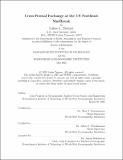| dc.description.abstract | Exchange across the semipermeable US Northeast shelfbreak front is a potential driver of irreversible change to the continental shelf waters, its productive ecosystem, and economically valuable fisheries. However, cross-frontal exchange is difficult to observe directly because it is highly intermittent, non-linear, and driven by both internal frontal instability and external forcing. In this thesis, I quantify eddy-driven exchange across the US Northeast shelfbreak front and its impact on the coastal ocean, starting on seasonal timescales and moving toward individual synoptic events. For this task, I take advantage of unprecedented multi-year observations from the Ocean Observatories Initiative (OOI) Coastal Pioneer Array (2014-2022). On seasonal timescales, the buoyancy-driven shelfbreak front is persistently trapped at the shelfbreak, which supports theoretical predictions of shelfbreak frontogenesis (Chapter 2). However, exchange across the shelfbreak front leads to a significant increase in salinity on the continental shelf between spring and fall. A volume budget of the subsurface continental shelf 'cold pool', habitat of the valuable benthic ecosystem, quantifies the contribution of eddy-driven advection to the observed salinity increase and explains the seasonal cycle of watermass variability on the shelf (Chapter 3). However, the multi-year averaged cold pool watermass budget does not capture the intermittency of cross-shelfbreak eddy-fluxes on synoptic timescales. Thus, I demonstrate how individual mooring timeseries can be used to capture the statistical distribution of eddy-driven exchange by assessing cross-shelfbreak eddy-covariance fluxes of salt and heat (Chapter 4). Mean eddy-covariance fluxes align well with previous residual estimates of cross-shelfbreak exchange to close coastal watermass budgets, and just 10-20% of statistically anomalous events are responsible for half the multi-year mean flux. To characterize rapid changes in continental shelf watermass properties over short timescales, I investigate the decline of seasonal stratification due to individual weather events and identify signatures of cross-shelfbreak exchange in wind-driven destratification (Chapter 5). Altogether, this thesis extends our understanding of the characteristics, timing, and magnitude of eddy-driven exchange across the US Northeast shelfbreak front on varying timescales. This information can help to inform how large-scale, long-term trends will impact the US East Coast coastal ocean and its marine ecosystem. | |
